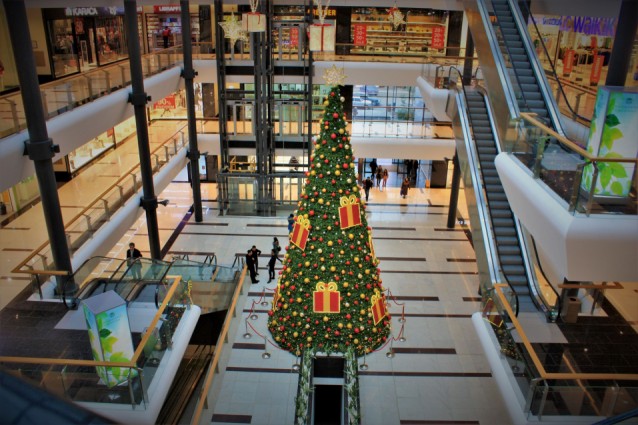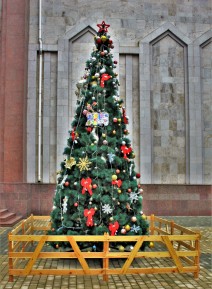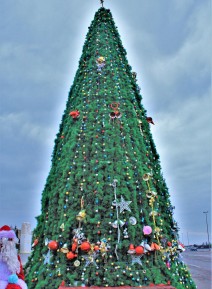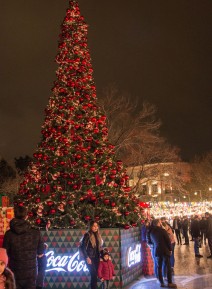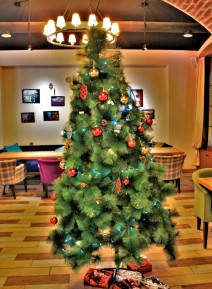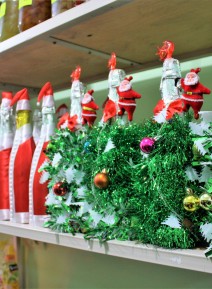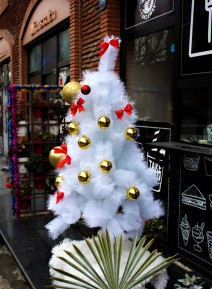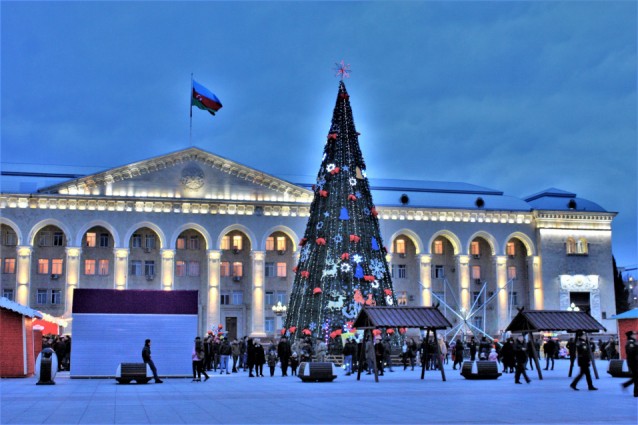Merry Christmas and Happy New Year from Visions of Azerbaijan!
The whole country is decked out for the holidays right now, with glowing lights and Christmas trees in all the stores and parks. My first time in Azerbaijan was around this time of year, and I was surprised to see that the holiday festivities so closely resembled those I was used to in the U.S. I started to wonder how it was that these lighted trees, which I associated with a Christian holiday, were everywhere in Azerbaijan in connection with a secular New Year’s celebration, so I turned to history to find out.
It turns out that there are various cultures around the world who used evergreens in their winter celebrations as a symbol of life during the dead months of winter. There are competing versions as to when this tradition first appeared in connection with Christmas. One story has a Christian missionary in the 3rd century interrupting a child sacrifice to pagan gods at a great oak tree and then encouraging people to look at the pine tree, which pointed to God in heaven, who did not want them to sacrifice their children.
In the neighboring Republic of Georgia, Christmas is celebrated with a chichilaki, a bundle of dried hazelnut or walnut branches in the shape of a pine tree that was decorated with fruit to represent the tree of life. This tradition was banned under Soviet rule, and there is no indication that it was ever adopted in Azerbaijan.
In the early 1500s, there are some recorded incidents of evergreens being used as symbols of Christmas in Latvia. Also, the Church at the time celebrated Adam and Eve Day on the 24th of December and often put on plays with trees representing the tree in the Garden of Eden. This practice was later banned, and people began setting up their own “Paradise Trees” in their homes, which often had cookies hung from them.
There is then the legend that Martin Luther, the founder of the German Lutheran church, was walking through the snowy woods around Christmas time planning a sermon and was struck by the beauty of the stars shining through the evergreen branches, so he brought a tree home and decorated it with candles to try to recapture this image for his family. This supposedly became the first time that lights were put on the trees.
Soon, lighted evergreen trees became a German Protestant Christmas tradition, and began spreading to other areas under German influence. It is entirely possible that the first Christmas trees in Azerbaijan came with a wave of German settlers in the 1800s. Even so, it did not become a major local tradition.
About the same time that German settlers were moving to Azerbaijan, German Christmas trees were making their way into Russian tradition through the family of Tsar Nicholas I. His wife, who admired this German custom, defied a Russian belief that pine trees symbolized death, and brought one into the royal palace to celebrate Christmas and give gifts to both royal and poverty-stricken children. From there, it trickled down into Russian society, as did a number of more western Christmas traditions.
By the early 1900s, the Christmas tree was fairly established in Russia, but when the Communists came to power, they did their best to abolish Christmas and all its symbols. In the mid-1930s, however, Stalin suddenly had a change of heart. His government brought the symbols back, this time in association with New Year's.
Over the course of the next several decades, these New Year’s celebrations became standard throughout the Soviet Union, and these formerly German Christian holiday symbols took root in traditionally Muslim republics such as Azerbaijan. Today in Azerbaijan, people of all faith backgrounds and nationalities rally around these lighted evergreen trees to celebrate life, love, and future hope during the cold darkness of winter.
Wherever you call home, and whatever tradition you come from, we hope that if you find yourself in Azerbaijan over the holidays, these familiar sights will bring you comfort and joy. May 2019 be a year of hope and love and find you warm and full and surrounded by those you hold dear.
